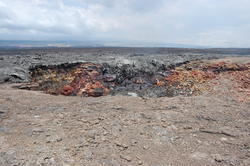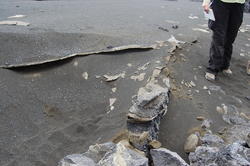Ka'u Desert
United States
 We started the day off at the end of Hilina Pali Road where we applied our sunscreen and got our gear together for our hike across the Ka'u Desert ahead of us.
We started the day off at the end of Hilina Pali Road where we applied our sunscreen and got our gear together for our hike across the Ka'u Desert ahead of us.
Day 4 took us on the path over the 1974 and 1959 lava flows, to look at a variety of features. Specifically, we started in the parking lot (Stop 1), and discussed regional extension that we had measured in the field exercise on day 3. Dikes of magma intruded into the subsurface beneath the rift zone. The added mass extended the lower part of the crust, but there was no matter being added to the top; this lead to thinning of the surface in order to compensate for the lack of matter. After we discussed the history of the rift zone, we started of on the trail toward Mauna Iki.
 Along the way, we observed a vertical surface of ropey Pahoehoe (Stop 2). The surface features formed on the top of the flow, and were therefore originally horizontal. The outside shell hardened, preserving these flow features. Then, when the insulated fluid part of the Pahoehoe received more lava from the source, the flow inflated, cracking the solid shell and pushing the block into the vertical position observed.
Along the way, we observed a vertical surface of ropey Pahoehoe (Stop 2). The surface features formed on the top of the flow, and were therefore originally horizontal. The outside shell hardened, preserving these flow features. Then, when the insulated fluid part of the Pahoehoe received more lava from the source, the flow inflated, cracking the solid shell and pushing the block into the vertical position observed.
 At multiple points during the death march through the dusty, barrend, yet beautiful Ka'u desert, volcanic ash layers were observed. First (Stop 3), we saw many small balls, some of which, upon close examination, had tiny cores. These little cores told us that they were accretionary lapilli. During an eruption, concentric layers of ash will form around a small core in the presence of moisture (kind of like a snowball that gets bigger as layers of snow stick to small ball you started with). There was also high percentage of lithic fragments (estimates up to 90%), fragments from the eruption that are not associated with the actual magma. A very explosive eruption will blast loose lots of pre-existing rock, and turn much of it into small, even ash-sized fragments. So the high amount of lithics suggests a significantly explosive eruption. What caused this particular eruption to be explosive? The interaction between water and magma will cause such an eruption. A likely source of water to cause such explosivity is groundwater. The next stop (Stop 4), showed ash fall deposits which follow topography in its bedding, filling in the lows. The ash that was formed by an explosive eruption by Kilauea was transported by wind. Here there were also accretionary lapilli. The lapilli and ash was eventually deposited filled in the topographic lows of the environment. Finally (Stop 6), a well layered deposit which showed signs of cross bedding was observed. The different sized particles formed clear, crossing layers, which indicate a flowing deposit as opposed to a fall deposit. A flowing deposit from an explosive eruption is a pyroclastic density current, which is a hot "cloud" of extremely hot volcanic gas and ash.
At multiple points during the death march through the dusty, barrend, yet beautiful Ka'u desert, volcanic ash layers were observed. First (Stop 3), we saw many small balls, some of which, upon close examination, had tiny cores. These little cores told us that they were accretionary lapilli. During an eruption, concentric layers of ash will form around a small core in the presence of moisture (kind of like a snowball that gets bigger as layers of snow stick to small ball you started with). There was also high percentage of lithic fragments (estimates up to 90%), fragments from the eruption that are not associated with the actual magma. A very explosive eruption will blast loose lots of pre-existing rock, and turn much of it into small, even ash-sized fragments. So the high amount of lithics suggests a significantly explosive eruption. What caused this particular eruption to be explosive? The interaction between water and magma will cause such an eruption. A likely source of water to cause such explosivity is groundwater. The next stop (Stop 4), showed ash fall deposits which follow topography in its bedding, filling in the lows. The ash that was formed by an explosive eruption by Kilauea was transported by wind. Here there were also accretionary lapilli. The lapilli and ash was eventually deposited filled in the topographic lows of the environment. Finally (Stop 6), a well layered deposit which showed signs of cross bedding was observed. The different sized particles formed clear, crossing layers, which indicate a flowing deposit as opposed to a fall deposit. A flowing deposit from an explosive eruption is a pyroclastic density current, which is a hot "cloud" of extremely hot volcanic gas and ash.
 As we climbed down the rocks into the central rift zone, the color of the lava flows became more yellowed than what we had previously been walking on (Stop 7). This is due to the oxidation of the rock. Water and heat are required to oxidize the minerals in the rock. A possible source for these might be steam produced from groundwater coming in contact with deeper, hotter rocks that have not completely cooled since their initial formation. There
As we climbed down the rocks into the central rift zone, the color of the lava flows became more yellowed than what we had previously been walking on (Stop 7). This is due to the oxidation of the rock. Water and heat are required to oxidize the minerals in the rock. A possible source for these might be steam produced from groundwater coming in contact with deeper, hotter rocks that have not completely cooled since their initial formation. There  were also some altered ash layers that were likely oxidized in a similar fashion. Upon going down a ridge, we came upon a more shelly section of Pahoehoe, with colorful evidence of hydrothermal alteration. This coloring around vents is again a sign of water being heated and steaming out of the rock. At this point, numerous spatter cones were observed in the distance, such that multiple vent sources for flows were seen. Around this area we were all very excited to be running into not just strands, but entire tufts of Pele's hair collected around rocks.
were also some altered ash layers that were likely oxidized in a similar fashion. Upon going down a ridge, we came upon a more shelly section of Pahoehoe, with colorful evidence of hydrothermal alteration. This coloring around vents is again a sign of water being heated and steaming out of the rock. At this point, numerous spatter cones were observed in the distance, such that multiple vent sources for flows were seen. Around this area we were all very excited to be running into not just strands, but entire tufts of Pele's hair collected around rocks.
 Upon closing in on one of the cones (Stop 8), we dropped a rock into the crater and counted the seconds until we heard it hit the bottom. With this information, accounting for the acceleration due to gravity, we were able to roughly estimate that the crater was around 150 meters deep, and the spatter cone was around 80 meters deep. We ate lunch here, and observed some very interesting flows from the December 1974 Ka'u Desert eruption that dripped into the pits.
Upon closing in on one of the cones (Stop 8), we dropped a rock into the crater and counted the seconds until we heard it hit the bottom. With this information, accounting for the acceleration due to gravity, we were able to roughly estimate that the crater was around 150 meters deep, and the spatter cone was around 80 meters deep. We ate lunch here, and observed some very interesting flows from the December 1974 Ka'u Desert eruption that dripped into the pits.
 After starting out again after lunch, we characterized black sand tephra (Stop 9) near a vent, which only served to show a general representation of the windblown mineralogy. Here we learned about the layers of hardened caliche that we saw interbedded with the ash deposits. These are formed by drying of surface water, causing mineral crystals to precipitate and start forming a hardened layer. With the surface water benig dried up, water from the subsurface is "wicked" up toward the dry surface where more minerals precipitate out as this new water is evaporated. As this contines, the thin layer of caliche is formed.
After starting out again after lunch, we characterized black sand tephra (Stop 9) near a vent, which only served to show a general representation of the windblown mineralogy. Here we learned about the layers of hardened caliche that we saw interbedded with the ash deposits. These are formed by drying of surface water, causing mineral crystals to precipitate and start forming a hardened layer. With the surface water benig dried up, water from the subsurface is "wicked" up toward the dry surface where more minerals precipitate out as this new water is evaporated. As this contines, the thin layer of caliche is formed.
 We finally reached Mauna Iki (Stop 10), where we observed lava sheets proximal to the vents, and lava tubes more distal from the vent. The lava comes out of the vents and spreads out in sheets and only organizes into more intricate plumbing systems further away from the vent. Because lavas organize into plumbing systems like this, the flow can be insulated and travel much longer distances than if it were to only spread out in sheets like it does near the vent.
We finally reached Mauna Iki (Stop 10), where we observed lava sheets proximal to the vents, and lava tubes more distal from the vent. The lava comes out of the vents and spreads out in sheets and only organizes into more intricate plumbing systems further away from the vent. Because lavas organize into plumbing systems like this, the flow can be insulated and travel much longer distances than if it were to only spread out in sheets like it does near the vent.
 Finally, heading out to the road, the group saw the footprints, preserved in the ash deposits, of people caught in the 1790 pyroclastic eruption of Kilauea (Stop 11). The footprints are thought to belong to people who lived in the area, as well as warriors from the war party of Keoua.
Finally, heading out to the road, the group saw the footprints, preserved in the ash deposits, of people caught in the 1790 pyroclastic eruption of Kilauea (Stop 11). The footprints are thought to belong to people who lived in the area, as well as warriors from the war party of Keoua.
Stop Locations
| Stop # |
1 |
2 |
3 |
4 |
5 |
6 |
7 |
8 |
9 |
10 |
11 |
| Latitude, '19.' |
.34178 |
.34321 |
.34518 |
.34484 |
.34498 |
.34762 |
.35259 |
.35483 |
.35616 |
.34724 |
.35560 |
|
Longitude, '-155.'
|
.27453 |
.27915 |
.28814 |
.29250 |
.29383 |
.30484 |
.31086 |
.31399 |
.32705 |
.35367 |
.36145 |
Prepared by Jesse Vavrek, Hung Pham, and Caitlin Traver
Created by Hung Pham on Tuesday, 12 October 2010 and updated on Tuesday, 19 October 2010








